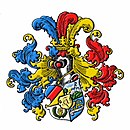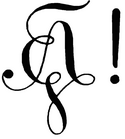Fraternity of Alemannia Giessen
|
Fraternity of Alemannia Giessen |
||||||
|---|---|---|---|---|---|---|
| coat of arms | Circle | |||||

|

|
|||||
| Basic data | ||||||
| University location: | to water | |||||
| University / s: | Justus Liebig University Giessen and Technical University of Central Hesse | |||||
| Founding: | December 11, 1861 in Giessen | |||||
| Corporation association : | association-free | |||||
| Color status : | colored | |||||
| Colours: |
|
|||||
| Fox colors: |
|
|||||
| Type of Confederation: | Men's association | |||||
| Position to the scale : | beating | |||||
| Motto: | Viribus Unitis! | |||||
| Website: | www.alemannia.de | |||||
The Alemannia fraternity is a striking and colorful student union in Giessen .
history
Foundation phase
On December 11, 1861, the Alemannia student association was founded in the Giessen promenade with the aim of reducing the supremacy of the corps at the University of Giessen . In 1862 the Alemannia developed into a student union, which merged with the fraternity Germania and the Wingolf to form the Giessen President's Convent in order to counterbalance the Giessen Seniors' Convent . Due to differences in content, the Presidential Convent dissolved again in the winter semester of 1863/64. On November 14, 1863, the Alemannia finally became a fraternity and from February 17, 1869, together with the Germania fraternity, formed the Giessen Deputy Convent . At the Franco-German War 1870-71 16 members of Alemannia participated. In the years 1873 to 1877, the Alemannia had to suspend due to a lack of members and was only able to resume active operations on April 16, 1877. In the winter semester of 1878/79 she joined the Eisenach Deputy Convent . In 1881 she became a member of the General Convention of Deputies , later the German Burschenschaft ; Alemannia belonged to the then arminist tendency .
1890 founded the old boys association of Alemannia, which significantly to the laying of the cornerstone of the 1901 inaugurated Alemanni house was that of today Aktivitas inhabited.
The time up to the Second World War
At the First World War 196 members of Alemannia participated, of whom 33 died.
In 1922, Alemannia joined the White Circle and continues to follow its principles to this day. In 1925 she joined the Old White Cartel .
In the winter semester 1930/31 the Alemannia consisted of 253 old men and 93 members of the Aktivitas.
When the German Burschenschaft was to be incorporated into the National Socialist German Student Union in 1935 , the Aktivitas of Alemannia refused to remain in the DB, left it and joined the Old Burschenschaft . From the winter semester 1937/38 the Alemannia continued to exist as Kameradschaft V or as Kameradschaft on the Alemannenhaus ; from 1943 as Kameradschaft Karillon or Kameradschaft Kießling .
During the Second World War , the Alemanni House was confiscated by the Wehrmacht in 1940 and used for air defense purposes, so that the comradeship had to switch to other fraternity houses for their active operations. 53 members of the Alemannia died in the Second World War.
post war period
After the end of the war, the Alemanni House was forcibly rented to the Labor and Occupation Costs Office and could only be partially used again for active operations in 1955 and completely in 1960. In 1950 the Alemannia was involved in the re-establishment of the German fraternity. In the same year the old white cartel was opened again. At the foundation festival in 1951, a part of the Aktivitas refused to wear colors and to beat the scales, so that the Aktivitas was suspended from the old rulers. These students then founded the Giessen Burschenschaft Wartburg .
Alemannia became a member of the German fraternity again in 1952.
From 1972 to 1993 the Alemannia Ring belonged to white fraternities .
In 1993 an apartment house with 15 residential units was built on the neighboring property of the connecting house, which is used as a student residence.
In 2009 Alemannia left the German fraternity and has not belonged to any corporation since then .
Color and motto
The band of the Alemannia has the colors blue-red-gold with golden percussion . The foxes are colored blue-red-blue . A light blue cloth cap is worn as headgear .
The motto of Alemannia is: Viribus Unitis!
Known members
- Karl Wilhelm Altheim (1899–1961), Mayor of Frankfurt am Main
- Georg Heinrich Arcularius (1893–1968), professor of animal breeding and animal nutrition
- Emil Berndt (1874–1954), member of the Reichstag, district mayor of the Schöneberg district of Berlin
- Alfred Filbert (1905–1990), SS-Obersturmbannführer
- Karl Glässing (1866–1952), Lord Mayor of Wiesbaden and Chief Financial Officer in Darmstadt
- Wilhelm Glässing (1865–1929), Lord Mayor of Darmstadt, member of the Hessian state parliament
- Franz Maximilian Groedel (1881–1951), cardiologist and university professor
- Isidor Maximilian Groedel (also: Isidor Mayer Groedel; 1850–1921), physician
- Hans Georg Gundel (1912–1999), ancient historian, holder of the chair for ancient history at the University of Giessen
- Wilhelm Gundel (1880–1945), classical philologist, professor at the University of Giessen
- Hugo Hepding (1878–1959), classical philologist, folklorist and librarian
- Hermann von Ihering (1850–1930), doctor, zoologist and paleontologist, director of the Museu paulista in São Paulo, Brazil
- Adam Karrillon (1853–1938), doctor and writer
- Carl Krauch (1887–1968), chemist, industrialist, military manager in the National Socialist German Empire
- Wilhelm Löhr (1889–1941), surgeon and university professor
- Karl Lohmann (1866–1946), member of the Prussian state parliament, member of the Reichstag
- Erwin Ohlemutz (1912–1942), classical archaeologist
- Karl Schilling (1889–1973), member of the Hessian state parliament, member of the Reichstag
- Otto Schmidtgen (1879–1938), paleontologist and director of the Natural History Museum in Mainz
- Carlsteueragel (1848–1919), Cologne city planning officer
- Adolph Windecker (1857–1939), member of the Hessian state parliament
Member directories :
- Willy Nolte (Ed.): Burschenschafter Stammrolle. List of the members of the German Burschenschaft according to the status of the summer semester 1934. Berlin 1934. P. 1033.
- Paul Wentzcke : Fraternity lists. Second volume: Hans Schneider and Georg Lehnert: Gießen - The Gießener Burschenschaft 1814 to 1936. Görlitz 1942, T. Alemannia. Pp. 128-145.
See also
literature
- Hans-Georg Balder : The German fraternities. Their representation in individual chronicles. Hilden 2005, pp. 153-154.
- Hugo Böttger (Ed.): Handbook for the German fraternity. Berlin 1912, pp. 344-345.
- Karl Glässing : History of the Giessen fraternity Alemannia: 1862-1892. Giessen 1892.
- Herman Haupt (Hrsg.): Handbook for the German fraternity. 6th edition (edited by Max Droßbach and Hans Hauske), Frankfurt am Main 1932, p. 389.
- Joachim Hönack, Gernot Schäfer (Red.): Vivat Academia! Student associations at the University of Giessen in the past and present. A contribution to the 400th anniversary of the university and to the city's history . Accompanying volume for the exhibition with short chronicles of the corporations involved. Essen 2007, ISBN 978-3-939413-02-8 , pp. 149-154.
- Jürgen Setter: A brief history of the connections in Giessen . Verlag Friesland, Sande 1983, ISBN 3-9800773-0-6 , pp. 149-152.
Individual evidence
- ↑ Meyers Konversationslexikon . 5th edition, Leipzig 1896, supplement to the article student associations .
- ^ EH Eberhard: Handbook of the student liaison system. Leipzig, 1924/25, p. 47.
- ^ Friedrich Waas: History of the Giessen Wingolfs. In: Hans Waitz (Hrsg.): History of the Wingolf connections. Darmstadt 1914, pp. 288-289.
- ^ Anonymus: From the Wingolf - Eine Blüthenlese. 3rd edition, Halle / Erlangen 1875.
- ↑ Jürgen Setter: A short history of the connections in Giessen . Verlag Friesland, Sande 1983, ISBN 3-9800773-0-6 , p. 150.
- ↑ Hugo Böttger (Ed.): Handbook for the German fraternity. Berlin 1912, p. 345.
- ↑ http://denkxweb.denkmalpflege-hessen.de/61675/
- ↑ https://www.deutsche-digitale-bibliothek.de/item/UBEPQNCZVGY2X3AYJTZ7YY7WOIPYPLLO
- ↑ Archived copy ( memento of the original from January 24, 2016 in the Internet Archive ) Info: The archive link was inserted automatically and has not yet been checked. Please check the original and archive link according to the instructions and then remove this notice.
- ↑ Paul Gerhardt Gladen : Gaudeamus igitur: The student societies past and present. Callwey, Munich 1986, p. 216.
- ^ German university calendar. Winter semester 1913/14. Leipzig 1913, p. 101.
Web links
- Official homepage of the Alemannia Gießen fraternity
- Collection of color cards from the Alemannia Gießen fraternity
Coordinates: 50 ° 34 '56.93 " N , 8 ° 41' 3.41" O
